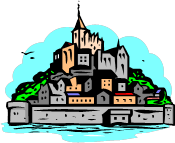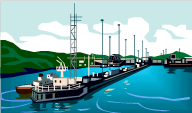A Journey Through Ancestral Lands in Finland and Russia
Every genealogist wants to walk the land of his ancestors. That’s why I went to Finland and Russia. There I did some walking, and my husband/tech advisor did a lot of driving. Our trip included three very different segments.
First Leg
 Flying on Icelandair, we landed in the capital city of Helsinki and stayed a couple of days. This allowed us to get over any jet lag and learn a little about modern Finnish culture. By staying in a downtown hotel we could walk everywhere we wanted to go. The iconic Finnish department store, Stockmann’s, lay just across the street. I looked at the famous Iitala glassware there but did not purchase any.
Flying on Icelandair, we landed in the capital city of Helsinki and stayed a couple of days. This allowed us to get over any jet lag and learn a little about modern Finnish culture. By staying in a downtown hotel we could walk everywhere we wanted to go. The iconic Finnish department store, Stockmann’s, lay just across the street. I looked at the famous Iitala glassware there but did not purchase any.
The morning after our arrival we walked to see the famous Church of the Rock (Temppeliaukio) and then went on to the National Museum of Finland (http://www.nba.fi/en/nationalmuseum). We viewed their exhibits of artifacts arranged in chronological order from prehistoric times until today. I found the 19th-century throne room just astounding. It includes a real red velvet and gilt throne and luminous portraits of every Russian czar and czarina who ruled over the Duchy of Finland (1809-1917). My grandmother’s family emigrated to America during the Duchy period.
Second Leg
 Leaving Helsinki, we picked up a rental car for the next part of our trip. As we drove along modern highways through endless forests we soon learned that rural Finland is very sparsely populated. Northeast of Helsinki we traveled past the farms where my Mattila and Miettinen families had lived. At the end of the day we reached the Koli National Park (http://www.luontoon.fi/retkikohteet/kansallispuistot/koli/Sivut/Default.aspx) in the North Karelia region of Finland. All I can say is, “Wow”. No wonder this beautiful area provided inspiration for great Finnish artists and composers.
Leaving Helsinki, we picked up a rental car for the next part of our trip. As we drove along modern highways through endless forests we soon learned that rural Finland is very sparsely populated. Northeast of Helsinki we traveled past the farms where my Mattila and Miettinen families had lived. At the end of the day we reached the Koli National Park (http://www.luontoon.fi/retkikohteet/kansallispuistot/koli/Sivut/Default.aspx) in the North Karelia region of Finland. All I can say is, “Wow”. No wonder this beautiful area provided inspiration for great Finnish artists and composers.
The Koli resort has a commanding view of thick forests and the gorgeous Lake Pielinen, the fourth largest of the nearly 200,000 lakes in Finland. We stayed two nights, drinking in the view, eating authentic Karelian meals (my comfort food!), and visiting the sauna.
In the morning, we hiked through the forest over to the nearby restored Mattila barn (not my Mattila family). The trail has interpretive signs in Finnish and English telling about the historic settlements in the area. My Lampinen family lived on the farms surrounding Lake Pielinen, so I eagerly learned all about the slash and burn agriculture that probably provided the livelihood for my ancestors. Later we drove around the lake to see the various settlements where my people had lived. They all lie in the Juuka parish of the Evangelical Lutheran Church of Finland, and we stopped in to see this church.
Third Leg
From Koli we drove to the southeastern city of Lappeenranta on Lake Saimaa. Early the next morning, as in really early at 7:00 a.m., we embarked on a river boat tour through the Saimaa Canal to the Baltic port city of Vyborg, Russia. I felt more than a little apprehensive. We were the only Americans on the boat.
My fears proved groundless, and these 5-hour boat rides to and from Vyborg became a highlight of my trip. I had wonderful conversations with my fellow passengers, and we enjoyed tasty lunches in the dining room. A Finnish singer provided entertainment using a songbook he distributed to everyone. Everyone knew all his songs, and with the words provided even I could participate a little.

In Vyborg, the tour company helped us through Customs and took us to our hotel. On the bus, we had our first glimpse of a Russian city. It seemed as if time had stopped in 1947. That year, in an agreement to settle the damages of World War II, Finland had ceded 12% of its territory to the Soviet Union. The cession included the ancient Finnish port city of Viipuri. The town became known as Vyborg, and nearly all the Finns walked out to be resettled in the Karelian area of Finland. Today, Vyborg is populated with Russians, not Finns. Virtually no one there speaks any English.
My great-grandparents, Alex Mattila and Ada Lampinen, married in Viipuri in 1904. I wanted to see the city even though few Finns remain there. Armed with an approximate address for where the couple had lived, we walked from our hotel to find the neighborhood. It is the same neighborhood where Vladimir Lenin lived a few years later to plot the Russian Revolution. On the way there, we passed small shops and parks; Vyborg is very pedestrian-friendly. I could imagine my great-grandparents walking these same streets. Unfortunately, we could not visit the church where they were married because it was destroyed in the war.
After visiting that area, we walked to the famous Vyborg Castle, first built by the Swedes in the 1200’s. We climbed to the top where I could look out the narrow windows into the distance to where my Mattila and Myllynen families had lived in the rural around Viipuri. The price of admission to the castle included a visit to the museum filled with photos of Viipuri from the time my family lived there.
Home Again
From Vyborg we boarded the canal boat and returned to Lappeenranta to pick up our rental car. On the way back to Helsinki, we took the route through Kotka. After my great-great grandfather Anders Mattila died, my widowed great-great grandmother Elizabeth Myllynen relocated there from the Viipuri area. We drove past the property where she had lived.
Then we were off to Helsinki to board our plane home. I hated to leave this beautiful country of lakes and forests. But even as I left, I knew that now I have pictures of where my ancestors lived in my head. I have a better knowledge of the geography of their surroundings and of their way of life. I am so glad I went.
